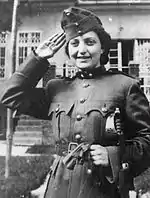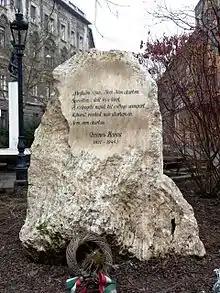Hannah Szenes
Hannah Szenes (often anglicized as Hannah Senesh or Chanah Senesh; Hebrew: חנה סנש; Hungarian: Szenes Anna; July 17, 1921 – November 7, 1944) was a poet and a Special Operations Executive (SOE) member. She was one of 37 Jewish SOE recruits from Mandate Palestine parachuted by the British into Yugoslavia during the Second World War to assist anti-Nazi forces and ultimately in the rescue of Hungarian Jews about to be deported to the German death camp at Auschwitz.[2]

Szenes was arrested at the Hungarian border, then imprisoned and tortured, but refused to reveal details of her mission. She was eventually tried and executed by firing squad.[2] She is regarded as a national heroine in Israel, where her poetry is widely known and the headquarters of the Zionist youth movements Israel Hatzeira, a kibbutz and several streets are named after her.
Early life

Szenes was born on July 17, 1921, to an assimilated Jewish family in Hungary. Her father, Béla, a journalist and playwright, died when Hannah was six years old. She continued to live with her mother, Kathrine, and her brother, György.
She enrolled in a Protestant private school for girls that also accepted Catholic and Jewish pupils; however those of the Catholic and Jewish faith had to pay double and three times the amount Protestants paid. After her mother thought it is too expensive, Szenes was let to pay only double amount, considering her as a "Gifted Student". This, along with the realization that the situation of the Jews in Hungary was becoming precarious, prompted Szenes to embrace Zionism, and she joined Maccabea, a Hungarian Zionist students organization.
Immigration to Nahalal

Szenes graduated in 1939 and decided to emigrate to what was then the British Mandate of Palestine in order to study in the Girls' Agricultural School at Nahalal. In 1941, she joined Kibbutz Sdot Yam and then joined the Haganah, the paramilitary group that laid the foundation of the Israel Defense Forces.
The scholar of Jewish Mysticism Joseph G. Weiss was in love with her and parts of their correspondence were published after his death.
In 1943, she enlisted in the British Women's Auxiliary Air Force as an Aircraftwoman 2nd Class. Later the same year, she was recruited into the Special Operations Executive (SOE) and was sent to Egypt for parachute training.
Arrest and torture
On March 14, 1944, she and colleagues Yoel Palgi and Peretz Goldstein[2] were parachuted into Yugoslavia and joined a partisan group. After landing, they learned the Germans had already occupied Hungary, so the men decided to call off the mission as too dangerous.[2]
Szenes continued on and headed for the Hungarian border. At the border, she and her companions were arrested by Hungarian gendarmes, who found her British military transmitter, used to communicate with the SOE and other partisans. She was taken to a prison, stripped, tied to a chair, then whipped and clubbed for three days. She lost several teeth as a result of the beating.[4]
The guards wanted to know the code for her transmitter so they could find out who the parachutists were and trap others. Transferred to a Budapest prison, Szenes was repeatedly interrogated and tortured, but only revealed her name and refused to provide the transmitter code, even when her mother was also arrested. They threatened to kill her mother if she did not cooperate, but she refused.[2]
While in prison, Szenes used a mirror to flash signals out of the window to prisoners in other cells and communicated using large cut-out letters that she placed in her cell window one at a time and by drawing the Magen David in the dust.
 Hannah Szenes with members of Kibbutz Sdot Yam. (4th from left)
Hannah Szenes with members of Kibbutz Sdot Yam. (4th from left) Hannah Szenes in a Hungarian army uniform as a Purim costume
Hannah Szenes in a Hungarian army uniform as a Purim costume Hannah Szenes in 1940
Hannah Szenes in 1940
Trial and execution
She was tried for treason in Hungary on October 28, 1944. There was an eight-day postponement to give the judges more time to find a verdict, followed by another postponement, this one because of the appointment of a new Judge Advocate. She was executed by a firing squad on November 7, 1944.[5]
She kept diary entries until her last day. One of them read: "In the month of July, I shall be twenty-three/I played a number in a game/The dice have rolled. I have lost," and another: "I loved the warm sunlight."[2]
Her diary was published in Hebrew in 1946. Her remains were brought to Israel in 1950 and buried in the cemetery on Mount Herzl, Jerusalem. Her tombstone was brought to Israel in November 2007 and placed in Sdot Yam.[6]
During the trial of Rudolf Kastner, Hannah's mother testified that during the time her daughter was imprisoned, Kastner's people had advised her not to obtain a lawyer for her daughter. Further, she recalled a conversation with Kastner after the war, telling him, "I don't say that you could have saved my daughter Hannah, but that you didn't try – it makes it harder for me that nothing was done."[7]
After the Cold War, a Hungarian military court officially exonerated her. Her kin in Israel were informed on November 5, 1993.
Poetry, songs and plays
Szenes was a poet and playwright, writing both in Hungarian and Hebrew. The following are four of her better known poems. The best known of these is "A Walk to Caesarea", commonly known as Eli, Eli ("My God, My God"). The well-known melody was composed by David Zahavi. Many singers have sung it, including Ofra Haza, Regina Spektor, and Sophie Milman. It was used to close some versions of the film Schindler's List:



My God, My God, I pray that these things never end,
The sand and the sea,
The rustle of the waters,
Lightning of the Heavens,
The prayer of Man.[8]
אלי, אלי, שלא יגמר לעולם
החול והים
רשרוש של המים
ברק השמים
תפילת האדם
Another of her poems begins,
A voice called, and I went.
I went, for a voice called.
The following lines are from the last poem she wrote, "Ashrei Hagafrur", after she was parachuted into a partisan camp in Yugoslavia:
,אַשְׁרֵי הַגַּפְרוּר שֶׁנִּשְׂרַף וְהִצִּית לֶהָבוֹת
.אַשְׁרֵי הַלְּהָבָה שֶׁבָּעֲרָה בְּסִתְרֵי לְבָבוֹת
...אַשְׁרֵי הַלְבָבוֹת שֶׁיָדְעוּ לַחְדוֹל בְּכָבוֹד
.אַשְׁרֵי הַגַּפְרוּר שֶׁנִּשְׂרַף וְהִצִּית לֶהָבוֹת
Blessed is the match consumed in kindling flame.
Blessed is the flame that burns in the secret fastness of the heart.
Blessed is the heart with strength to stop its beating for honour's sake.
Blessed is the match consumed in kindling flame.[9]
The following lines were found in Hannah's death cell after her execution:
One—two—three ... eight feet long,
Two strides across, the rest is dark ...
Life hangs over me like a question mark.
One—two—three ... maybe another week,
Or next month may still find me here,
But death, I feel, is very near.
I could have been twenty-three next July;
I gambled on what mattered most,
The dice were cast. I lost.[10]
In popular culture
- The Legend of Hannah Senesh, a play about Szenes authored by Aaron Megged, was produced and directed by Laurence Merrick at the Princess Theatre in Los Angeles in 1964. Szenes was played by Joan Huntington.
- Hanna's War, a film about Szenes's life directed by Menahem Golan, was released in 1988. Szenes was portrayed by Maruschka Detmers.
- Blessed is the Match: The Life and Death of Hannah Senesh, directed by Roberta Grossman, is a documentary film that recounts the events of Hannah's life. It was released in 2008.[11]
References
- "דף הבית". palmach.org.il.
- Hecht, Ben. Perfidy, first published by Julian Messner, 1961; this edition Milah Press, 1997, pp. 118-133. Hecht cites Bar Adon, Dorothy and Pessach. The Seven who Fell. Sefer Press, 1947, and "The Return of Hanna Senesh" in Pioneer Woman, XXV, No. 5, May 1950.
- "דף הבית". palmach.org.il.
- Blessed Is the Match: The Life and Death of Hannah Senesh (2008 film)
- Baumel-Schwartz, Judith Tydor (2010). Perfect heroes: the World War II parachutists and the making of Israeli collective memory. University of Wisconsin Press. p. 30. ISBN 978-0-299-23484-3.
- Tombstone of WWII poet and spy Hannah Szenes arrives in Israel, Haaretz, 25 November 2007.
- Hecht, Ben. Perfidy. 1961, p. 132
- "Poems, by Hannah Senesh". The Jewish Week. December 22, 2010. Archived from the original on March 2, 2016. Retrieved January 21, 2016.
- Hannah Senesh: Her Life & Diary (paperback ed.). New York: Schocken Books. 1973. p. 256. ISBN 0-8052-0410-5.
- Hannah Senesh: Her Life & Diary (paperback ed.). New York: Schocken Books. 1973. p. 257. ISBN 0-8052-0410-5.
- "Blessed Is the Match: The Life and Death of Hannah Senesh (2008)". Internet Movie Database. IMDb. Retrieved January 1, 2015.
Bibliography
- חנה סנש: חייה, שליחותה ומותה, in Hebrew. 1952.
- Diario, cartas, iniciación literaria, misión y muerte, memorias de la madre, 1966. in Spanish. 396 pages.
- Hannah Senesh, Her Life & Diary, Schocken Books, 1972.
- Masters, Anthony. The Summer That Bled; The Biography of Hannah Senesh. New York: St. Martin's Press, 1972. OCLC 677086
- Goldenberg, Linda. In Kindling Flame: The Story of Hannah Senesh, 1921-1944. New York: Lothrop, Lee & Shepard Books, 1985. ISBN 0688027148 OCLC 10302495
- Hay, Peter. Ordinary Heroes: Chana Szenes and the Dream of Zion. G.P. Putnam's Sons, 1986. ISBN 0399131523 OCLC 13395114
- Whitman, Ruth. The Testing of Hannah Senesh Detroit: Wayne State University Press, 1986. ISBN 0814318533
- Maxine Rose Schur, Hannah Szenes: A Song of Light, Philadelphia, 1986. ISBN 0827606281
- Betzer, Oded. The Paratrooper Who Didn't Return. World Zionist Organization, 1989.
- Ransom, Candice F. So Young to Die: the Story of Hannah Senesh. Scholastic, 1993. ISBN 0590446770 OCLC 28137831
- Senesh, Hannah, and Marge Piercy (foreword). Hannah Senesh: Her Life and Diary. Jewish Lights Publishing, 2004. ISBN 9781580233422 OCLC 269444258
- Gozlan, Martine, Hannah Szenes, l'étoile foudroyée. Paris: Ed. de l'Archipel, 2014. ISBN 9782809815818 OCLC 897806840 In French.
- Shalom, Avner, Hannah Senesh, Poems within the Depth, שירים מן המעמקים, The Association of Global Art Publishing House, Budapest and Caesarea 2018 ISBN 9786150033730 in English and Hebrew, apendix A and B in Spanish and Lithuanian
External links
| Wikiquote has quotations related to: Hannah Szenes |
| Wikimedia Commons has media related to Hannah Szenes. |
- Video Lecture by Dr. Henry Abramson on Hannah Szenes
- Teacher's Study Guide
- Hannah Senesh Legacy foundation
- Jewish Community Day School, Brooklyn, New York
- Blessed Is The Match, a documentary film about Hannah
- Blessed Is The Match at Women Make Movies
- Hannah Szenes Biography at J-Grit: The Internet Index of Tough Jews
- Hannah Szenes: Poet, Hero, Martyr: Video lecture on Hannah Szenesh by Dr. Henry Abramson
- Hannah Szenes on Jewish.hu's list of famous Hungarian Jews
- Chana Szenes – The Match That Burns Forever
- Sophie Milman Version of Eli, Eli